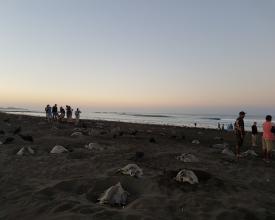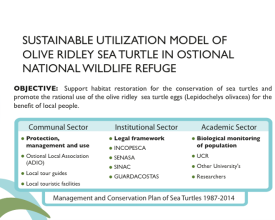
Building positive links between the Ostional community and the conservation of Olive ridley sea turtles

Ostional Wildlife Refuge is the second largest beach nesting site of Olive ridley sea turtles (Lepidochelys olivacea) in the world. With the simultaneous arrival of hundreds of turtles to the beach of Ostional, high mortality of eggs was observed due to over-excavation, illegal poaching of eggs and natural causes. This promoted the creation of the Refuge and the design of a project where government institutions and the community jointly implemented actions to improve the conditions of habitat protection and a regulated use of turtle eggs is permitted.
Context
Challenges addressed
high mortality of turtle eggs due to over-excavation, illegal poaching of eggs and natural causes
Location
Process
Summary of the process
The planning committee and management composed of ADIO, INCOPESCA, SINAC and the University of Costa Rica are jointly involved in action planning and project evalution. Some activities are performed jointly, others are performed separately, but always in pursuit of implementing the management plan. All contributions of the sectors are important in learning and empowerment. Representatives of ADIO give a fundamental contribution in volunteer hours. The contribution of the research is critical to ensure that the actions taken, but especially the use of the resource, are not hurting the nesting population. The contribution of INCOPESCA and SINAC is essential to ensure legality of the project, decreasing illegal extraction and sales of eggs.
Building Blocks
Commission for the management and protection of sea turtles.
1.By consensus of the interested parties, INCOPESCA, ADIO, UCR, and SINAC created a commission of co-management and created a legal framework established with executive decree DAJ-020-2005, in order to work together and this group of Co-management launches a management plan for the conservation and sustainable use of turtles (Lepidochelys olivacea) nesting on Ostional beach.
Enabling factors
The SINAC and INCOPESCA authorization and supervision of the Ostional Development Association (ADIO) to use eggs as a means of subsistence (consumption and sale). The community benefits from consumption of the egg as food and also to receive the economic resources that are distributed between people and social welfare, while contributing to the conservation of the turtle, through the cleaning of the beach and the care Of turtle hatchlings.
Lesson learned
Leaning from the results of the first phase (2006-2011) progress was made in fulfilling population recovery objectives. The analysis of research advances made in the last five years and the sessions valuation that each of the actors did on experiences informed the 2013 – 2016 5-year plan; so did negotiations and agreements between the parties.
Representatives of the ADIO, UCR, INCOPESCA and SINAC developed jointly and by consensus four products that were the basis for the development of the new five-year management proposal:
- A basic characterization of the roles of the actors and the main elements of their experience, which identified the keys to a successful plan for future use.
- An interpretation framework as reference to outline the guidelines of the use plan for the next five years;
- the principles governing the plan
- general and specific rules and objectives.
Distribution of profit to families
The ADIO represents 110 families of the Ostional community. They are the main partners responsible for implementing the actions of habitat maintenance, collecting eggs according to plan management and conservation and packaging of eggs. Of the ADIO sales, 70% are distributed to members and 30% are reserved for local development such as construction of roads, bridges, health centers and school resources. The direct benefit that each family receives are: an endowment of eggs for consumption, an equitable distribution of family income, scholarships for students, aid to elderly and pregnant adults.
Enabling factors
Ostional Development Association is a legal institution for engaging communities for collective benefit of the community. In this case the management and conservation of turtles is a model project developed by the community and for the community. The ADIO has partners and participates in assemblies of the people. It also has a Board of Directors who bears the burden of the project. They also form committees to monitor the actions of the management plan.
Lesson learned
The participation of all people in the project is critical to creating the collective consciousness about sustainability. Jobs are evenly distributed: beach cleaning and habitat management mainly engage men; protection of turtle infants and release of turtles, mainly women. Surveillance by ADIO is done mostly by men; and supervision of tourists who observe the arrival, by youth. In this way, the contribution of the project to local community welfare and conservation is evident. When communities see a benefit for their families in the wildlife, they are able to organize themselves in order to protect those resources that provide that well-being.
Impacts
Under new management practices the stakeholders made significant progress in all areas of management planning. Recognition of the community of Ostional for environmental protection and better protection of nesting turtles is increased.
Advances in research include various topics related to the state of the population and the development of a methodology to accurately count transects of turtle population "arrivals", which is now used worldwide.
The project provides social development benefits: 110 families are actively involved.
Benefits include:
- Scholarships to students.
- Equitable family income distribution.
- Support for older adults.
- Infrastructure development (roads, bridges, school, health center).
- Conservation impact: approximately 15 million turtles hatch each year.
Beneficiaries
Inhabitants of Ostional and neighboring communities
Ostional National Wildlife Refuge
Costa Rica university
National System of Conservation Areas
Olive ridley sea turtles (Lepidochelys olivacea)
Sustainable Development Goals
Story

In Costa Rica in 1970, aerial surveys showed that there were two mass nesting beaches for Olive ridley sea turtles, one of them being Playa Ostional Beach. Both are now protected areas and managed by the Ministry of Environment and Energy (MINAE). However only the National Wildlife Refuge Ostional has allowed a project that integrates the main objective of conservation of these species, while still allowing the use of eggs under certain circumstances, times and amounts. This ensures that the community may have a direct benefit of the resource, without losing sight of the main goal which is to preserve the nesting habitat of the sea turtles. Overall the roles of all participants are defined, goals are set and adaptive management of the marine protected area is performed under the existing conditions. This management approach has improved the understanding of the whole context of human-environment relationships. Through annual planning between the institutions of government and the community, economic and operational resources of both parties are optimized, which has improved the conservation of turtles and their eggs. Marine protected areas as Ostional can provide benefits like these, but also fishing or turtle watching activities without compromising the conservation objectives for the coastal marine ecosystems. Therein lies the success of conservation in Ostional.










